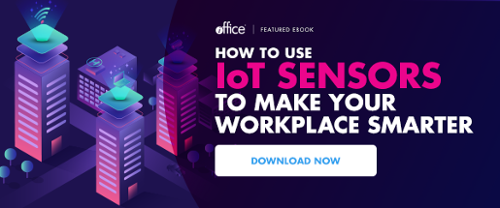What Happens When You Use Smart Data To Make Dumb Decisions


Imagine you notice a meeting room in your office that’s almost always empty. It seems like no one ever goes there, and IoT sensor data confirms it.
So you come to the only reasonable conclusion: That room is cursed.
You start stashing old boxes and mismatched equipment there until it resembles your kitchen’s junk drawer—just on a bigger scale.
Maybe this sounds like an exaggeration, but it illustrates an important point.
IoT sensors provide valuable insights that help us make better decisions, but sensor data can also mislead us. Here’s how it happens and how to avoid it.
The Danger of IoT Sensors: Relying on ‘Thin’ Data
Kay Sargent, senior principal and director of HOK’s WorkPlace practice, warns workplace leaders to avoid the trap of making decisions based on “thin” or inconclusive data.
The problem of thin data “is going to lead you to false conclusions,” she said. “For instance, this is a bad desk because no one is sitting in it, so we’re going to get rid of it. Maybe that desk didn’t have power. Or it was in a bad location. Or it was near a loud talker. You should be looking at it from multiple angles so you’re making better decisions—not just fast decisions.”
Although IoT sensors are becoming more advanced, most still offer just a single point of data.
They show occupancy, but they don’t offer insight into other factors that might influence occupancy. Going back to the meeting room, there could be many reasons why it isn’t being used. For instance:
- The conference room technology may not be working properly.
- The room may be too hot or too cold.
- It may have an unpleasant smell.
- The lighting may be too dim or too bright.
- Some of the chairs may be broken or uncomfortable.
- It may not look presentable for clients or new job candidates.
- Someone else may have booked the room for a recurring meeting that is no longer taking place.
It may seem like common sense, but sometimes you just need to take a closer look before deciding on the best way to use the space.
How To Use Thick Data Versus Thin Data To Make Decisions
While “thin data” is based on one single point or occurrence, “thick data” is gathered from multiple sources.
Some sources may be qualitative rather than quantitative; for instance, employee feedback. Workplace leaders should gather data from as many sources as they can before making a decision that affects their real estate portfolio, their company’s bottom line or their workforce.
Here are some examples of thick data that can collectively inform workplace decisions:
- Space utilization
- Asset utilization
- Service requests and maintenance records
- Employee surveys
- Conversation
- Observation
Another way to look at thin data versus thick data is that thin data exists in isolation, while thick data is integrated.
The Internet of Things offers us a wealth of data, but the data itself can only tell us so much. To get the best value from IoT sensor data, you need to use it with other workplace technologies. Here’s what that looks like in a best-in-class digital workplace:
- Sensors collect valuable real-time data about how employees use the workplace.
- Workplace leaders view sensor data within an integrated workplace management system (IWMS).
- Leaders respond, fulfilling immediate requests and anticipating future ones.
- Employees use workplace apps and kiosks to make requests that further inform decision-making.
iOFFICE’s clients are already using IoT sensors to respond to the needs of their workplace in real time and make smarter business decisions over time. By using IoT sensors with our IWMS and the iOFFICE Hummingbird employee experience app, they’re able to make decisions based on thick data rather than thin data.
For instance, they can see not only how often employees are physically present in a meeting room, but also how often that room appears to be booked via room reservation software. They can see what equipment is in that room and how often employees have requested service for the room.
If you’re looking to make more data-driven decisions in your workplace, we can help you select the right types of IoT sensors and integrate them with your existing workplace technology.
We can also help you make sense of your sensor data using our Insights module.
To learn more, talk with your account manager or request a demo of iOFFICE today.
